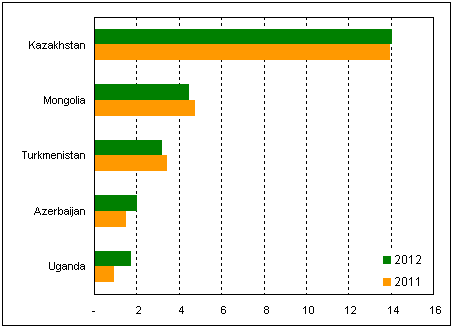Foreign direct investment (FDI) to landlocked developing countries (LLDCs) last year increased slightly from US$34.4 billion to $34.6 billion, continuing an uninterrupted upward trend that began in 2005, UNCTAD’s annual investment survey reveals.
FDI flows to this group of countries remained resilient even in the aftermath of the global economic crisis, raising hopes for investment growth in LLDCs in coming years, the World Investment Report 20131 notes.
The report, which is subtitled Global Value Chains: Investment and Trade for Development, was released today.
Many of the countries in the LLDC grouping have great potential, the report contends.
Central Asian landlocked economies, which still account for the vast bulk of FDI to LLDCs, especially Kazakhstan (figure 1), contain significant energy resources, including oil, gas and hydropower. While the primary sector will continue to attract investment to this region, it is the services sector that has registered the greatest increase in investor activity in percentage terms, the report notes. Although services are still not as important to LLDC economies as manufacturing is, they are gaining in the share of total investment and look set to continue their growth over the near future.
Last year saw a strengthening in South–South investment ties, as the majority of investment in LLDCs originated in developing countries, the report says. The share of greenfield investment projects in LLDCs – investment in industries or sectors new to a recipient country – that were from developing economies jumped from 41 per cent of total projects in 2011 to 66 per cent in 2012. West Asian economies, in particular, increased their involvement in LLDCs. The Republic of Korea replaced India as the top investor to this regional grouping, the report notes.
LLDCs continue to pursue regional integration and cooperation strategies to overcome the traditional structural disadvantages affecting their economies, the report notes. This year’s report argues that the development of land-linked economies via regional integration agreements, the strategic development of transport, and more sophisticated economic corridors will be essential for their economic development. In particular, the report highlights the potential for a modern Silk Road economy in Central Asia, including investment in new road and rail links. Among the five countries that make up the modern Silk Road economy2, average investment increased more than six-fold between 2000–2005 and 2009–2012 (table 1), indicating their growing attractiveness to investors.
Full Report - http://unctad.org/en/PublicationsLibrary/wir2013_en.pdf
Figure 1. Top 5 recipients of FDI flows in LLDCs, 2011 and 2012
(billions of US dollars)
Source: UNCTAD, World Investment Report 2013.
Table 1. FDI inflows to the Silk Road
(millions of US dollars)
Source: UNCTAD, World Investment Report 2013.



